This week I went looking for a book to help me answer some of my questions about the keys on my maple tree. I found From Seed to Maple Tree by Laura Purdie Salas, which is one book in a series of books for kids on different life cycles, including From Seed to Apple Tree
by Laura Purdie Salas, which is one book in a series of books for kids on different life cycles, including From Seed to Apple Tree , From Seed to Pine Tree
, From Seed to Pine Tree , From Caterpillar to Butterfly,
, From Caterpillar to Butterfly, and From Tadpole to Frog
and From Tadpole to Frog .
.
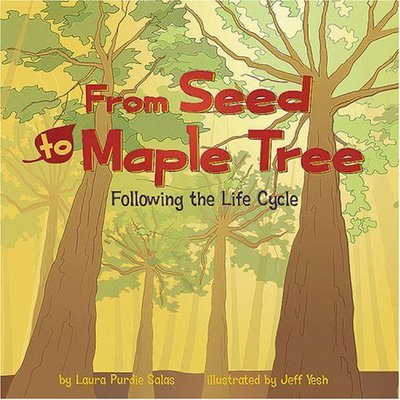
I found the book in our local library. It's one of a dozen or so kids books that explain the basics of how trees develop. I found the pictures most appealing in this book. Jeff Yesh is the illustrator for the entire the Life Cycle series and his pictures are big and bright, filling the whole page with color.
Salas begins by telling us that trees have life cycles too just like the animals.
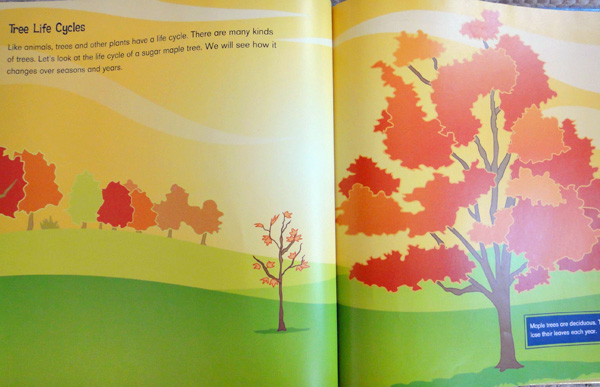
Every tree starts as a seed.
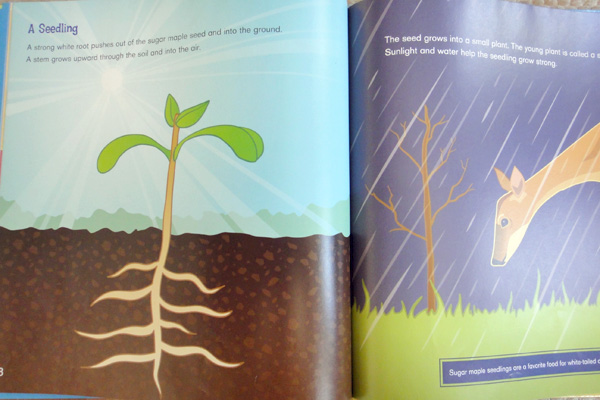
The maple tree, she tells us, grows about 1 foot each year and is called a seedling until it is 2 meters tall. After 30-40 years it becomes a mature tree. Its growth slows down and it begins to produce flowers. (Note: the maple tree in this book is a sugar maple, so its flowers look a little different from the bright green flowers that appeared on my Norway maple.)
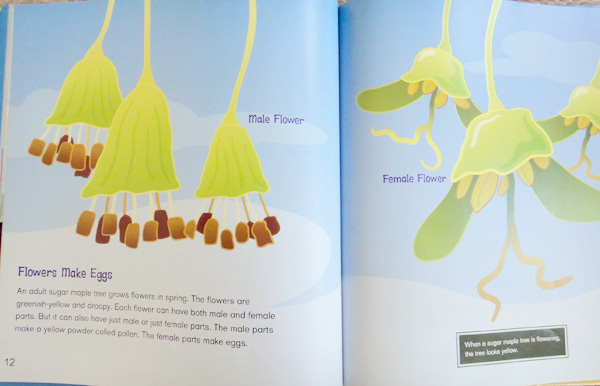
From Salas's description, it seems that the sugar maple is a monoecious tree, which means that one tree will have both male and female flowers. In fact, one flower may have both male and female parts. (After doing a little research, I found out that the Norway maple is like the ash tree and can be either monoecious or dioecious.) However the boy and girl flowers are arranged, pollen from the male parts is brought over to the female parts, with a little help from the birds and the bees, and you get fruit!
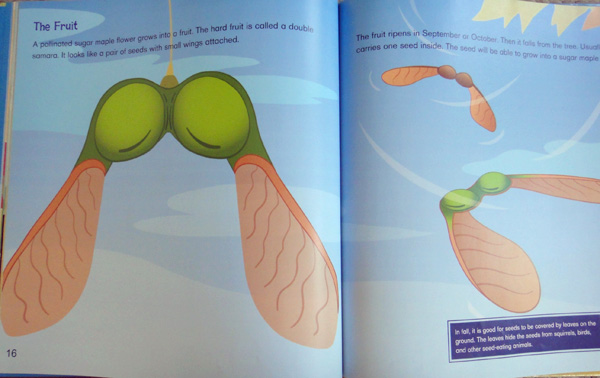
The book confirms that these little winged helicopter thingies are indeed the fruit of the maple tree. In the sugar maple, you can really see the two seeds in the large green section of the samara. The Norway maple fruit is a little different. It's all green and, as we discovered a couple of weeks ago, has a wider wingspan. Here's a picture one of the hundreds that have recently fallen off of the tree in front of my house.
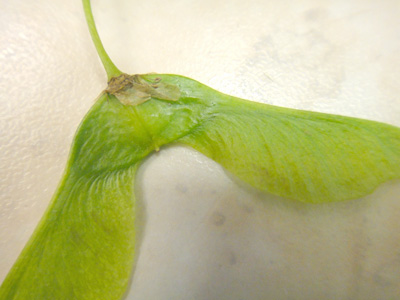
Salas explains that the maple fruit ripens on the tree and should fall from the tree in the fall. This makes me think that the samaras falling from all the Norway maples around me aren't ripe yet. Someone should tell them that, because they are everywhere! Apparently, the seeds need to hide in the fallen leaves to keep from being eaten by squirrels and birds.
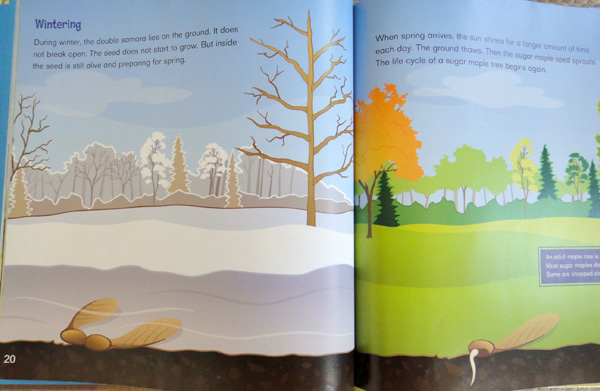
The book also explains that the seed has a better chance of developing into a new tree when it flies away from the parent tree. It seems to me that most seeds just fall straight down and so I've often wondered why there aren't just a million little baby trees under each mature tree. It turns out that the parent tree is using up all the nutrients in the soil right there, so the seed needs to travel somewhere else to find a place with enough water and food to grow. And then the cycle can begin again.
And now I've got to share with you the coolest website I found while looking for some info on tree flowers and fruit. It's Bob's Brain on Botany and is full of amazing, close-up pictures of tree flowers, including the sugar maple and the Norway maple. There's also a whole page with pictures of tree droppings (Yay, I love tree droppings!). Finally, he has an amazing section on tree flowers and fruit...
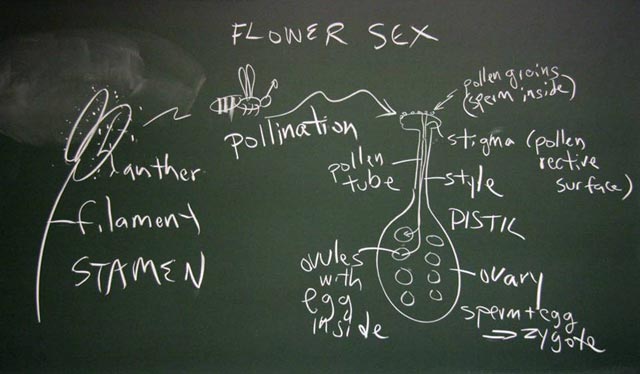

I found the book in our local library. It's one of a dozen or so kids books that explain the basics of how trees develop. I found the pictures most appealing in this book. Jeff Yesh is the illustrator for the entire the Life Cycle series and his pictures are big and bright, filling the whole page with color.
Salas begins by telling us that trees have life cycles too just like the animals.

Every tree starts as a seed.

The maple tree, she tells us, grows about 1 foot each year and is called a seedling until it is 2 meters tall. After 30-40 years it becomes a mature tree. Its growth slows down and it begins to produce flowers. (Note: the maple tree in this book is a sugar maple, so its flowers look a little different from the bright green flowers that appeared on my Norway maple.)

From Salas's description, it seems that the sugar maple is a monoecious tree, which means that one tree will have both male and female flowers. In fact, one flower may have both male and female parts. (After doing a little research, I found out that the Norway maple is like the ash tree and can be either monoecious or dioecious.) However the boy and girl flowers are arranged, pollen from the male parts is brought over to the female parts, with a little help from the birds and the bees, and you get fruit!

The book confirms that these little winged helicopter thingies are indeed the fruit of the maple tree. In the sugar maple, you can really see the two seeds in the large green section of the samara. The Norway maple fruit is a little different. It's all green and, as we discovered a couple of weeks ago, has a wider wingspan. Here's a picture one of the hundreds that have recently fallen off of the tree in front of my house.

Salas explains that the maple fruit ripens on the tree and should fall from the tree in the fall. This makes me think that the samaras falling from all the Norway maples around me aren't ripe yet. Someone should tell them that, because they are everywhere! Apparently, the seeds need to hide in the fallen leaves to keep from being eaten by squirrels and birds.

The book also explains that the seed has a better chance of developing into a new tree when it flies away from the parent tree. It seems to me that most seeds just fall straight down and so I've often wondered why there aren't just a million little baby trees under each mature tree. It turns out that the parent tree is using up all the nutrients in the soil right there, so the seed needs to travel somewhere else to find a place with enough water and food to grow. And then the cycle can begin again.
And now I've got to share with you the coolest website I found while looking for some info on tree flowers and fruit. It's Bob's Brain on Botany and is full of amazing, close-up pictures of tree flowers, including the sugar maple and the Norway maple. There's also a whole page with pictures of tree droppings (Yay, I love tree droppings!). Finally, he has an amazing section on tree flowers and fruit...

from Ohioense: Bob's Brain on Botany
... which includes everything you ever wanted to know about flower sex and an overview of a variety of different tree fruits -- all with cool roll-over graphics! I'm off to learn more....
... which includes everything you ever wanted to know about flower sex and an overview of a variety of different tree fruits -- all with cool roll-over graphics! I'm off to learn more....
